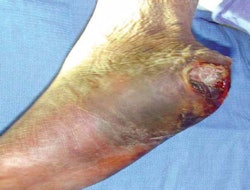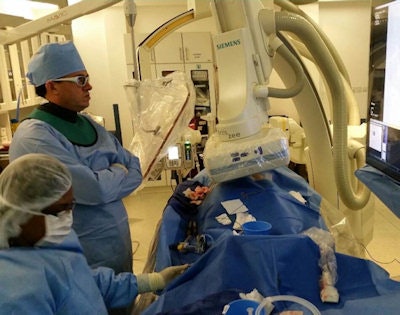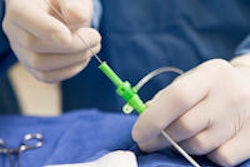
DUBAI - The creation of a dedicated service for diabetic patients with foot problems, in which interventional radiologists play a central role in limb salvage, is contributing to a dramatic reduction in the number of amputations in the United Arab Emirates (UAE).
Around 20% of the UAE's adult population has diabetes, and this amounts to an estimated 1.8 million people, according to Dr. Jamal Alkoteesh, chairman of the Clinical Imaging Institute and chief of interventional radiology at Al Ain Hospitals, UAE. About 8.3% of the global population is diabetic, and a limb is lost to diabetes every 20 seconds, he told attendees at last week's Total Radiology Conference at the annual Arab Health meeting.

The number of lower limb amputations from vascular causes is increasing rapidly, despite innovations in assessment, treatment, and wound care. Up to 70% of all lower leg amputations are performed on people with diabetes.
"Amputation is usually preceded by a foot ulcer. It is one of the most feared complications of diabetes, and the impact on a patient's life is immense," he said. "But amputation can be reduced by 49% to 85% by prevention, early detection, disease monitoring, revascularization, and patient and staff education."
Diabetes and its complications, such as peripheral vascular disease, are likely to constitute a sizable burden to the UAE, the magnitude of which is unknown, Alkoteesh explained. Cardiovascular morbidity and mortality are markedly increased in patients with diabetes, a foot ulcer, and peripheral artery disease (PAD), and the mortality rate is estimated to be about 50% at five years.
In the UAE, around 25% of patients with diabetes develop foot problems. The Health Authority of Abu Dhabi (HAAD) has expressed concern about the large number of people with diabetes who do not monitor their condition; in a survey by HAAD, only 59% keep tabs on their blood sugar levels, he explained.
In response to this crisis, the Diabetic Foot Clinic opened at Al Ain Hospital in 2010. A catheter lab and dedicated operating rooms and staff were established. Before the clinic opened, many patients undergoing a primary amputation had never had any diagnostic evaluation prior to their amputation, not even a simple ankle brachial pressure index (ABPI) test.
 Interventional radiologists are vital team members at the Al Ain Hospitals.
Interventional radiologists are vital team members at the Al Ain Hospitals.The clinic has had clinical benefits and economic ones. The average cost of revascularization, or limb salvage, is 2,000 euros ($2,256 U.S.), whereas the cost of an elective amputation is around 4,300 euros ($4,852 U.S.), and one amputation following a bypass failure will cost around 20,000 euros ($22,600 euros). Also, this does not take into account social and related health costs, according to Alkoteesh.
In endovascular treatment at the clinic, the prime goal is re-establishment of perfusion to relieve from rest pain, achieve healing of ulcers and gangrene, achieve limb salvage, and improve quality of life.
"The aim of revascularization is to restore direct pulsatile flow to at least one of the foot arteries, preferably the artery which supplies the anatomical region of the wound," he said. "The restoration of oxygenated blood may be important even when a primary amputation is planned to facilitate wound healing at the amputation site and to potentially lessen the extent of amputation and avoid a second one."
These patients have the right to a second chance and opinion, Alkoteesh said.

Overall, he had the following five recommendations for handling patients with diabetes with foot problems:
Screening tests are necessary to exclude PAD, particularly handheld Doppler ultrasound evaluation of flow signals from both arteries of the foot (posterior tibial and dorsalis pedis), and measurement of the ankle brachial index is vital. In cases of diagnostic uncertainty, the toe brachial index should be measured.
Plan your procedures. Think about this while reviewing the images, try to make hard decisions in advance, and do the procedure in your mind, step by step.
All patients must receive aggressive cardiovascular risk management, including smoking cessation, treatment of hypertension, and prescription of a statin, as well as low-dose aspirin or clopidogrel.
Multidisciplinary teamwork and a holistic approach are essential, including input from general practitioners and community services.
Treatment of PAD should be part of a comprehensive care plan, which should also include treatment of infection, frequent debridement, biomechanical offloading, and treatment of comorbidities. Patients with signs of PAD and a foot infection are at particularly high risk for major limb amputation, and they should be treated as an emergency, preferably within 24 hours.



















